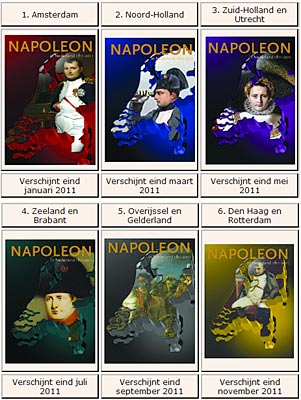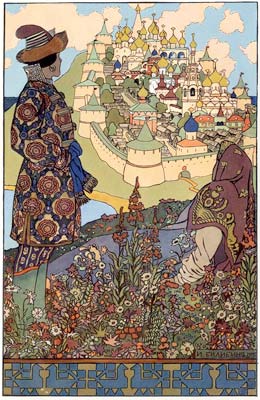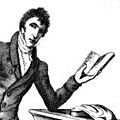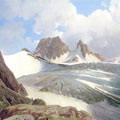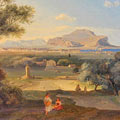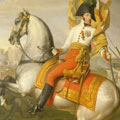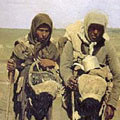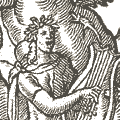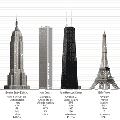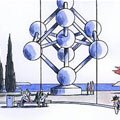Harry Clarke (1889-1931) uit Ierland
De periode 1870-1930 wordt wel eens The Golden Age of Illustration genoemd. Door het populaire Edwardian Gift Book was het geïllustreerde sprookjesboek in Engeland tot een uitzonderlijk hoog niveau gekomen. De meeste tekenaars die zo’n honderd jaar geleden actief waren, stonden onder invloed van het symbolisme en Jugendstil met zijn geaccentueerde lijnenspel. In deze serie vijf van deze illustratoren uit vijf verschillende landen die in hun unieke beeldtaal bekende sprookjes en sagen visualiseerden: Kay Nielsen, Edmund Dulac, Arthur Rackham, Ivan Bilibin en Harry Clarke.
By his late teens
Harry Clarke was studying stained glass at the
Dublin Art School. While there his
The Consecration of St. Mel, Bishop of Longford, by
St. Patrick won the gold medal for stained glass work in the 1910
Board of Education National Competition. Completing his education in his main field,
Clarke travelled to London, where he sought employment as a book illustrator. Picked up by London publisher
Harrap, he started with two commissions which were never completed:
Samuel Taylor Coleridge’s The Rime of the Ancient Mariner (his work on which was destroyed during the 1916
Easter Rising) and an illustrated edition of
Alexander Pope’s The Rape of the Lock. Difficulties with these projects made
Hans Christian Andersen’s Fairy Tales by
Hans Christian Andersen his first printed work, however, in 1916 a title that included 16 colour plates and more than 24 monotone illustrations. This was closely followed by an illustrations for an edition of
Edgar Allan Poe’s Tales of Mystery and Imagination: the first version of that title was restricted to monotone illustrations, while a second iteration with 8 colour plates and more than 24 monotone images was published in 1923. The latter of these made his reputation as a book illustrator (this was during the golden age of gift-book illustration in the first quarter of the twentieth century: Clarke’s work can be compared to that of
Aubrey Beardsley, Kay Nielsen, and
Edmund Dulac). His work was influenced by both the passing
Art Nouveau and coming
Art Deco movements. His stained glass was particularly informed by the French Symbolist movement.
Bron:
en.wikipedia.org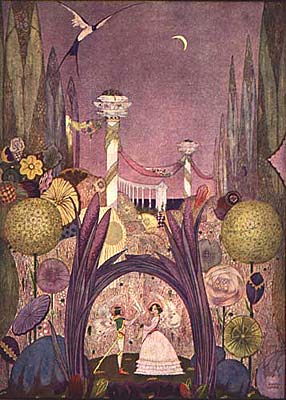
illustratie van Harry Clarke
Harry Clarke’s geillustreerde boeken (1916-1928)
The Rime of the Ancient Mariner van Samuel Taylor Coleridge (onvoltooid)
The Rape of the Lock van Alexander Pope (onvoltooid)
Sprookjes van Hans Christian Andersen (16 afbeeldingen in kleur en 24 in monotoon) (1916)
Tales of Mystery and Imagination van Edgar Allan Poe (1923)
The Years at the Spring (1920) (12 afbeeldingen in kleur)
Sprookjes van Charles Perrault
Faust van Goethe (1925) (8 afbeeldingen en kleur en 70 in mono- en duotoon)
A History of a Great House van Jameson Irish Whiskey (1924)
Elixir of Life van Geofrey Warren (1925)
Selected Poems van Algernon Charles Swinburne (1928)
Harry Clarke [ surlalunefairytales.com] | Harry Clarke Gallery | artpassions.net
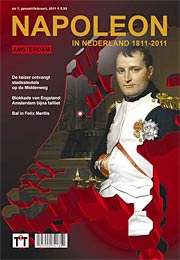 Omdat het in oktober precies tweehonderd jaar geleden is dat Napoleon een bezoek aan Nederland bracht, geeft thematijdschriften.nl dit jaar zes tijdschriften uit over Napoleon. Daarin staat telkens een bepaalde regio in Nederland centraal. Ook is het dit jaar tweehonderd jaar geleden dat Napoleon in ons land de burgerlijke stand invoerde. Iedereen die aan stamboomonderzoek doet, zal hem hiervoor dankbaar zijn, want het volgen van het voorgeslacht vóór 1811 is vaak een ondoenlijk karwei. Terwijl Napoleon‘s leven van dag tot dag gedocumenteerd is, is er heel weinig bekend over de tijd dat hij in ons land verbleef. De kleine dictator reisde van Zeeland naar Texel, van de kust in het westen tot aan de grens met Duitsland in het oosten. Twee weken logeerde hij met zijn nieuwe vrouw Marie Louise, de dochter van keizer Franz I van Oostenrijk in het paleis op de Dam. Napoleon in Nederland 1811-2011 is een combinatie van een historisch tijdschrift en een reisgids. Met het tijdschrift in de hand kunnen de voetstappen die Napoleon in ons land zette worden nagevolgd.
Omdat het in oktober precies tweehonderd jaar geleden is dat Napoleon een bezoek aan Nederland bracht, geeft thematijdschriften.nl dit jaar zes tijdschriften uit over Napoleon. Daarin staat telkens een bepaalde regio in Nederland centraal. Ook is het dit jaar tweehonderd jaar geleden dat Napoleon in ons land de burgerlijke stand invoerde. Iedereen die aan stamboomonderzoek doet, zal hem hiervoor dankbaar zijn, want het volgen van het voorgeslacht vóór 1811 is vaak een ondoenlijk karwei. Terwijl Napoleon‘s leven van dag tot dag gedocumenteerd is, is er heel weinig bekend over de tijd dat hij in ons land verbleef. De kleine dictator reisde van Zeeland naar Texel, van de kust in het westen tot aan de grens met Duitsland in het oosten. Twee weken logeerde hij met zijn nieuwe vrouw Marie Louise, de dochter van keizer Franz I van Oostenrijk in het paleis op de Dam. Napoleon in Nederland 1811-2011 is een combinatie van een historisch tijdschrift en een reisgids. Met het tijdschrift in de hand kunnen de voetstappen die Napoleon in ons land zette worden nagevolgd.